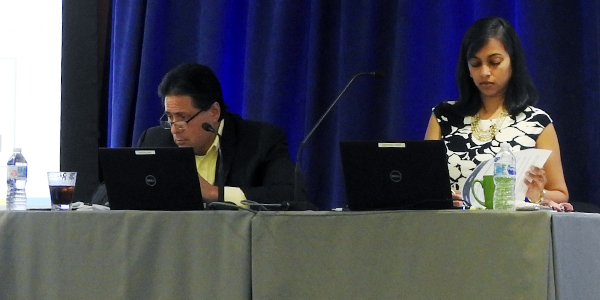Two substation fires that occurred earlier this year revealed weaknesses in utilities’ incident response procedures and command structures.
Donnie Bielak, PJM’s manager of reliability engineering, presented a Feb. 28 “Lessons Learned” report by NERC to stakeholders Tuesday. The report did not disclose the location of the incidents.
In the first case, an arc flash on a closed 12-kV feeder circuit breaker cabinet in an enclosed substation sparked a fire. Four technicians at the scene heard the explosion, evacuated and called 911 after determining the third-party alarming system had not yet contacted emergency authorities.
Bielak said it was unclear which of the technicians should have served as incident commander, hampering effective communications with firefighters. A dead secondary battery for the substation card reader also forced first responders to break into the facility, despite existing rules that no one enter the facility without an escort.
In the second incident, a 230-kV transformer high-side bushing failed in an outdoor substation. Bielak said responding utility and fire department personnel arrived without the proper equipment for transformer fire suppression.
Corrective actions for utilities include:
- Implement policy that the first person to discover a fire must report it via 911 regardless of any central station monitoring that may be present.
- Perform a review of the effectiveness of the fire entry procedure for indoor substations and update it as appropriate along with the applicable training.
- Expand the fire entry procedure to include situations in which qualified personnel could already be present at the site. This procedure should identify who is the incident commander, who must call for the fire department, and what assistance, if any, do company personnel provide the fire department.
- Review fire entry requirements with the fire department to clarify the requirement that utility personnel should not enter the building prior to the fire department declaring the building safe.
- Coordinate with the fire department to establish the practice of immediately mobilizing a foam unit in the case of substation and switchgear fires, whether indoor or outdoor.
- Ensure expectations from the fire department are understood and documented on what assistance company personnel are supposed to do.
- Ensure additional equipment inside the substation is maintained.
- Ensure fire alarms at all substations work on the operator human machine interface (HMI) screen and are audible.
Drones Deployed to Save Money, Time
Bielak said drone usage is growing across the RTO as companies use the devices in place of helicopters to survey major storm damage, identify line repairs and inspect power plants, wind farms and gas pipelines, among other uses.
The drones save time and money, Bielak said, and have provided essential support during storm recovery. In the aftermath of Hurricane Maria, a drone was used to string lines between structures on either side of uncrossable terrain in Puerto Rico.
The technology has its limitations, however. Short flying times of 20 to 45 minutes prevents long-distance transmission line inspections and government regulations complicate where drones can fly safely.
Spring Restoration Drill Invites Sent

PJM’s Alpa Jani told the committee that invitations for the 2019 spring restoration drill went out April 3.
System restoration coordinators and transmission and generator operators with nuclear units, black start units and units with a hot start-up time of four hours or less received an email mandating participation in the systemwide drill on May 21 and 22. Recipients must complete the exercise in compliance with NERC standards.
Coordinators schedule the exercise twice a year and participation is required once every two years.
Manual First Reads
While there were no endorsements scheduled for Tuesday’s meeting, members heard first reads of several manual revisions, including:
- Manual 1: Periodic cover-to-cover review to update terminology and guidelines for control center and data exchange requirements.
- Manual 3: Biannual review to update transmission operating procedures.
- Manual 10: Clarifies existing language for prescheduling operations.
- Manuals 11, 13 and 28: Clarifies the impact of operationalizing gas contingencies on reserve requirements and reserve market eligibility.
- Manual 13: Periodic cover-to-cover review and changes to align with new Markets Gateway functionality for resource-limitation reporting to be implemented June 1.
- Manual 36: Annual update requirement.
– Christen Smith



